In 1929, New Zealand began what grew to become our longest running series of postage stamps. These are known as Health Stamps, stamps to promote children's health. Each year, a stamp or set of stamps was issued carrying a surcharge for health to raise funds for children's Health Camps. Finally, in 2017, with dropping sales, the funds raised by these issues had become much less than the cost of designing and printing so it was decided to discontinue the Health Stamp Series.
I have decided to feature this entire set on my blog, in large pages so the stamps can be seen as a collection. I will also feature certain issues on their own pages and link them to this collection. This is the final part of our Health Stamp collection, covering the years from 1990 until 2016.
Fast Links.
1995 2000 2005
The relationship between children and their pets has been a recurring theme in the Health Stamp series with many interesting and attractive designs being produced. While often thought to be similar, the cat and the dog are two entirely different animals. Where a dog becomes attached to his family, willing to share in every aspect of their life, a cat will remain aloof and independent even though the reality is they are totally dependent on humans.
1995 2000 2005
1990 Jack Lovelock - 40c + 5c 1990 George Nepia - 80c + 5c
Date of Issue: 25 July 1990.
Designer: T Crilley, Marlborough Sounds.
Printer: House of Questa, England.
Process: Lithography.
Quantities: 40c - 1.33m.
80c - 0.48m.
Sporting Heroes
During the late 80s and early 90s, the Health Stamp Series appears to have lost direction as far as its theme goes. Since ending the children's pets theme we got some children's paintings, Royal children, a couple of years of sporting heroes all thrown in with an issue on dolphins. All make good subjects for Health Stamps but not the same as some of those earlier series spanning a number of years. To me, this gives the impression of being a bit random.
The two sportsmen featured in this issue were Jack Lovelock and George Nepia. Jack Lovelock's career in athletics during the 1930s, reached its peak with his winning the 1500 metres at the 1936 Olympic Games in Berlin. George Nepia created a New Zealand record by playing in 38 consecutive matches for his country. His achievements in rugby include 46 matches as an All Black fullback, including nine test matches.
1990 - 40c Health with green runs and patches.
At first, I thought these marks might have been postal cancellations but they are actually from the printing process which makes this stamp a printing error.
1991 Hector's Dolphin - 45c plus 5c. 1991 Hector's Dolphin - 80c plus 5c.
Date of Issue: 24 July 1991.
Designer: Heather Arnold, Auckland, NZ.
Printer: Leigh Mardon, Australia.
Process: Lithography.
Quantities: 45c - 1.23m.
80c - 0.38m.
The 1991 Health Issue featured Hector's Dolphins named after Sir James Hector, a notable 19th century New Zealand scientist. Hector's Dolphins are easily distinguished by their distinctive black, grey and white markings. They are a small dolphin species, with a rounded dorsal fin. And like most dolphins, they will escort a boat into a harbour or follow inshore fishing vessels.
Hector's Dolphin is found only in New Zealand waters and only in small numbers. Although the species ranges from Kaipara Harbour to Foveaux Strait, they are most often seen around the South Island. It is believed that now only three to four thousand of these beautiful creatures exist. A tiny number with which to guarantee the continuation of the species, and a good reason for concern about their survival.
Hector's Dolphin prefers to stay close to the coast, seldom swimming more than eight kilometres offshore. These shallow waters are the dolphins' home - their feeding grounds and the place where they breed. And it is here that they are in most danger because of the fishing activities of men, such as being entangled and drowned in gillnets.
1992 Anthony Wilding - 45c + 5c. 1992 Stewie Dempster - 80c + 5c.
Date of Issue: 12 August 1992.
Designer: Terry Crilley, Marlborough Sounds, NZ.
Printer: Southern Colour Print, New Zealand.
Process: Lithography.
Quantities: 45c - 1.59m.
80c - 0.46m.
Sporting Heroes.
Once again the health issue for 1992 returned to the theme of sporting heroes. This time it was Anthony Wilding in the sport of tennis and Stewie Dempster in the sport of cricket. Between 1907 and 1914 Anthony Wilding was an international champion, making a major contribution to tennis in New Zealand before his career and life were cut short by World War I.
With a test match batting average of 65.7, he is one of our all-time greatest batsmen. No other New Zealand cricketer has ever matched the batting average of Charles Stewart Dempster.
I have included the miniature sheet as I rather like the design of placing the stamp against the background of the New Zealand flag along with a cricket bat and tennis racket.
The relationship between children and their pets has been a recurring theme in the Health Stamp series with many interesting and attractive designs being produced. While often thought to be similar, the cat and the dog are two entirely different animals. Where a dog becomes attached to his family, willing to share in every aspect of their life, a cat will remain aloof and independent even though the reality is they are totally dependent on humans.
1993 Boy with dog - 45c + 5c. 1993 Girl with cat - 80c + 5c.
Date of Issue: 21 July 1993.
Designer: Karen Odiam, Wellington, NZ.
Printer: Southern Colour Print, Dunedin, NZ.
Process: Lithography.
Quantities: 45c - N/A.
80c - N/A.
This issue marks the 75th Anniversary of Children's Health Camps. It is not been my intention to use many miniature sheets in this series of Heath Stamps but with this issue, I decided to make another exception. It seems like there were a number of great miniature sheet designs during the period. You can see the separate stamps in more detail below the sheet.
Each of the four stamps in this set depicted children doing some activity involving health. In the background is an older stamp from the Health Stamp series mostly with a similar theme. I have included the older stamps for comparison.
1994 Children playing ball - 45c. 1939 'Beachball' Health Stamp - 2d.
1994 Child and Nurse - 45c. 1949 'Nurse' Health Stamp - 1d.
1994 Education in Health Camps - 45c. 1969 Dr Elizabeth Gunn,
Founder of Health Camps - 4c.
1994 Smiling Boy - 80c. 1931 'Blue Boy' 2d.
Date of Issue: 20 July 1994.
Designer: Dave Gunson, Auckland, NZ.
Printer: Leigh-Mardon, Australia.
Process: Lithography.
Quantities: 45c - 0.76m.
45c - 0.76m.
45c - 0.76m
80c - 0.4m.
Triangular stamps, we have not seen these in the Health Stamp Series since the Princess of 1943. They have not been common in any other New Zealand stamps either. Both stamps show children performing some physical activity. The boy on the 45c stamp is skateboarding while the girl on the 80c is riding a bike.
1995 Boy on skateboard - 45c + 5c.
1995 Girl on bicycle - 80c + 5c.
Date of Issue: 21 June 1995.
Designer: Paul Martinson, Masterton, NZ.
Printer: Leigh-Mardon, Australia.
Process: Lithography.
Quantities: 45c - 1.67m.
80c - 0.44m.
1996 Child buckled in car seat - 40c + 5c 1996 Child on pedestrian crossing - 80c + 5c
Road Safety was the theme of the 1996 Health Issue. The two stamps showed two examples of keeping young children safe. The stamps were designed by Helen Casey of New Zealand and then ended up being printed in three different countries. First, the two gummed values were printed by Joh Enschedé, Netherlands. The Self-adhesive coil stamp was printed by Australia Post - Sprintpak, Australia. When the design of the lower value was changed (see below) there was not the time for the new design to be printed overseas so it was printed by Southern Colour Print, New Zealand.
Date of Issue: 6 June 1996.
Designer: Helen Casey, Auckland.
Printer: Joh Enschedé, Netherlands,
Australia Post-Sprintpak, Australia;
Southern Colour Print, New Zealand.
Process: Lithography.
The Disappearing Teddy Bear.
The 1996 Health Issue is famous for the teddy bear stamp, a rejected design from which some quantities were issued in error. Above can be seen the teddy bear on the left with a normal example for comparison on the right. I am unsure what has caused this colour difference to the example shown above so I believe it could either be due to the quality of this image or the fact that a different printer was used. (See above)
Although the teddy bear has his own little seat belt, his presence was found to indicate that the accompanying baby was facing the direction of travel, in contravention of NZ safety guidelines. Since the theme of the issue was Child Safety, the teddy bear design was ordered to be withdrawn and replaced with the design showing the baby minus his teddy bear.
The 1997 Health stamp designs were the result of a 'Design a Stamp' competition based on the theme of 'Healthy Living'. The competition was open to all New Zealand school children up to the age of 18 and was divided into three age categories.
Date of Issue: 18 June 1997.
Designer: Georgia Dumergue, Auckland, New Zealand;
Anita Pitcher, Palmerston North, New Zealand;
Fern Petrie, Auckland, New Zealand.
Printer: Southern Colour Print, New Zealand.
Process: Lithography.
1997 Child Collecting Fruit - 40c + 5c.
1997 Child at the Beach - 40c + 5c. 1997 Child Riding a Horse - 80c +5c.
Child Safety was again the theme for 1998. The two values show children involved in water activities. In the low value, the child is wearing a life jacket to promote the idea of children wearing life jackets when on a boat or near the water. Also, life jackets can be used to keep young children safe until they learn to swim. On the second value, the scene shows a young child being taught to swim. Confidence in the water, with the ability to float or swim, can actually be taught at a very young age and could prove to be a lifesaver should the child accidentally fall into a pool or other water hazard. In this case, the parent is holding the child while he learns to kick.
Date of Issue: 24 June 1998.
Designer: Sea Sky Design, Paraparaumu, New Zealand.
Printer: Gummed stamps and miniature sheet:
Southern Colour Print, New Zealand;
Self-adhesive coil stamp:
Sprintpak-Australia Post, Australia.
Process: Lithography.
A child wearing a life jacket. A child learning to swim.
1998 - 40c + 5c. 1998 - 80c + 5c.
Here we are at the bottom of my third Health Stamp page. I had no idea this project would prove to be so big. The focus of this year’s Children’s Health stamp issue is children’s books and their contribution to the education, health and well-being of our children. Like parables, these stories were intended not only to enlighten but also to educate the reader/listener.
Date of Issue: 19 June 1999.
Designer: Ann Adams, Wellington, New Zealand.
Printer: Southern Colour Print, New Zealand;
Process: Lithography.
Greedy Cat, by Joy Cowley, A Lion in the Meadow, by Margaret Mahy,
1999 - 80c + 5c. 1999 - 40c + 5c.
Hairy Maclary and Friends, Lynley Dodd.
1999 - 40c +5c.
I have included the First Day Cover as I like the postal strike. "I Love Books." I think that was rather a clever idea.
1999 - 40c +5c.
I have included the First Day Cover as I like the postal strike. "I Love Books." I think that was rather a clever idea.
Teddy Bears and Dolls.
Date of Issue:- 5th October 2000.
Designer:- Stamps Business, Wellington.
Printer:- Southern Colour Print, New Zealand.
Process:- Offset Lithography.
2000 White mohair bear - 40c + 5c
2000 French porcelain and American wood dolls - 80c + 5c
I don't usually like to display stamps joined together like this but I believe if I separated them we would lose the full effect of the set. This issue combined the two value Health Issue with another 4 stamps to produce a larger stamp issue called Bears & Dolls. You will notice the two health stamps in the bottom left-hand corner.
We all had dolls or teddy bears when we were young. It's part of being a child and important to the emotional health of the child. This issue shows a collection of dolls and teddy bears, some new and some pre-loved, some extremely rare and some common. I hope this brings back memories for all of us. How many of you can still say you have your favourite doll or teddy.
Date of Issue:- 1st August 2001.
Designer:- Comm Arts Design, Wellington, New Zealand.
Printer:- Southern Colour Print, New Zealand.
Process:- Offset Lithography.
2001 Out Riding - 40c + 5c. (self-adhesive)
The idea behind this stamp is the new freedom that a bike gives to a child. I remember how much further I could roam when I got my first bike. The roads were rough gravel but still, we got around, met up with friends and explored areas far beyond our usual home area.
2001 Family Time - 40c + 5c. 2001 Catching Air - 90c + 5c.
The lower value of the two gummed stamps shows a family out riding, are getting exercise while enjoying time together.
The higher value shows BMX - Bicycle Motocross. The bikes are stronger, designed to take the knocks of the rough, bumpy race tracks. It has become a very popular sport.
Date of Issue:- 7th August 2002.
Designer:- Ross Jones of Watermark, Wellington.
Printer:- Southern Colour Print, New Zealand.
Process:- Offset Lithography.
The 2002 Children's Health Stamp Issue focused on the benefits of healthy living, and the importance of eating a variety of food from the four main food groups - fruit and vegetables; breads and cereal foods; milk and dairy products; and lean meat, fish, eggs, nuts and pulses. After all, 'we are what we eat', and maintaining a balanced diet plays a significant role in ensuring our long-term health.
I don't like using miniature sheets but surprisingly, I have struggled to find images of the single stamps that were good enough for this blog. There were three stamps in the issue, two larger gummed and one smaller adhesive. Of course, the one shown above was part of the miniature sheet so it is gummed too. All three stamps feature healthy food, showing their colours textures and shapes.
Date of Issue:- 6th August 2003.
Designer:- Gerad Taylor, Watermark, Wellington.
Printer:- Southern Colour Print, New Zealand.
Process:- Offset Lithography.
The health theme for 2003 was Children's Playgrounds. Found in backyards, schools and parks throughout the country, they play a vital role in keeping our children fit, healthy, strong and confident. Playgrounds offer opportunities for children to test personal limits, learn new skills and socialise with others - all with the full support of parents and teachers.
Girl on the hanging bars - 40c Adhesive.
Boy on a swing - 40c. Girl playing Hopscotch - 90c.
Date of Issue:- 1st September 2004.
Designer:- Chrometoaster, Wellington.
Printer:- Southern Colour Print, New Zealand.
Process:- Offset Lithography.
The next Health Subject was 'A Day at the Beach.' The idea is an old one in the Health Stamp series, going right back almost to the beginning, to 1933 and 1935. New Zealand is surrounded by water so for most people, there is always a beach nearby. Every summer, the sand, the sea, the sunshine and the fresh air beckon families their way, offering opportunities to indulge in a lazy sunbathe or, for the more adventurous, water sports ranging from swimming and surfing to sailing, diving and water skiing.
Again I had the problem of poor quality images so had to use the miniature sheet. The little 45c to the left is a copy of the adhesive, in this case, gummed like the rest of the sheet. The three stamps all show beach activities.
Date of Issue:- 3rd August 2005.
Designer:- Donna Cross, Three Eyes Limited.
Printer:- Southern Colour Print, New Zealand.
Process:- Offset Lithography.
Boy and Girl with their dog.
45c Adhesive.
Children and their pets have been a popular theme that has often appeared in the Health Stamp series. Research has shown that having a family pet provides a number of benefits for children.
One of the more important is for children's future relationships with people. A child who learns to care for an animal, treating it kindly and patiently, is also learning to treat (and trust) people in the same way. Children develop important self-esteem and self-confidence while gaining valuable skills in non-verbal communication, compassion and empathy. For example, patting and stroking a pet is exchanging love in a non-verbal manner.
Of course, pets also bring physical benefits as a means of exercise and entertainment for children, with plenty of opportunities for laughter and delight. They give unconditional love, loyalty and affection, simply accepting children for who and what they are and giving cuddles unreservedly – usually when they’re needed most.
Girl with her horse - 45c. Boy and his rabbit - 90c.
Date of Issue:- 2nd August 2006.
Designer:- Cue Design, Wellington.
Printer:- Southern Colour Print, New Zealand.
Process:- Offset Lithography.
In 2006 the theme returned to 'Children Eating Healthy.' Eat colours, be healthy! That’s the message of ‘5+ A Day the colourway’ – a global campaign that’s encouraging people young and old to eat five or more servings of colourful fruit and vegetables every day.
Above in this miniature sheet, you can see the five stamps included in this issue, each showing a different colourful healthy food. Eating by colours is an interesting idea often mentioned as regards healthy eating.
In its web site, NZ Post wrote:- "In schools and communities throughout New Zealand, our children are learning one of the great secrets to long-lasting good health: ‘5+ A Day the colourway’. What’s more, the lesson is easy to apply: with just three servings of vegetables and two servings of fruit a day in the colours of the 5+ A Day logo, our youngsters get the vitamins, minerals and phytochemicals they need to stay healthy and fit. It’s fun, it’s delicious and it’s nutritious too!"
Two colourful First Day Covers from the 2006 Health Stamp Issue. Above with have the miniature sheet FDC while below we have the five individual stamps FDC.
Date of Issue:- 5th September 2007.
Designer:- Donna McKenna, Wellington.
Printer:- Southern Colour Print, New Zealand.
Process:- Offset Lithography.
In a world where tumult and destruction dominate the headlines, we all hope for peace – especially for our children and their children’s children. That’s why ‘A Peaceful World’ was chosen as the theme for the 2007 Children’s Health Stamps: to remind us all that we have a role to play in creating peaceful and violence-free environments – at home and beyond.
The three Children’s Health stamps illustrated the ‘Peaceful World’ theme through some well-known symbols of peace from nature – the peace lily, the dove and the Japanese crane. Held safely in children’s hands, they communicate the importance of trust, respect and a willingness to change: ‘hands-on peace’.
The Peace Lily - 50c + 10c. (Adhesive).
The White Dove of Peace - 50c + 10c. Japanese Crane Paper Folding - $1.00 + 10c.
Children's Health - Investing in the Future.
Date of Issue:- 2nd July 2008.
Designer:- Martin Bailey, Auckland, New Zealand.
Printer:- Southern Colour Print, New Zealand.
Process:- Offset Lithography.
In 2008 NZ Post issued a set of four stamps to mark the Beijing 2008 Olympic Games. Three of these designs were used for the 2008 Health Issue as well. Where the Olympic Issue used adult athletes on the stamps, the 2008 Health Issue featured children. What is unusual about these stamps is that they set on their lower corner rather than their lower side as can be seen in the illustration above.
50c+10c – Excel. (Adhesive)
50c+10c – Inspire. $1.00+10c – Passion
80th Anniversary of Health Stamps.
Date of Issue:- 7th September 2009.
Designer:- Hamish Thompson, Wellington, New Zealand.
Printer:- Southern Colour Print, New Zealand.
Process:- Offset Lithography.
For 80 years, New Zealand Post has been a proud supporter of Children’s Health Camps. Beginning in 1929, every year, they have issued a stamp or set of stamps, with each stamp carrying a surcharge that is then donated to the Health Camps to help support them in their work. These issues usually included miniature sheets, First Day Covers and other collector items to help promote sales of these stamps.
In 2009 they celebrated the 80th anniversary of Children’s Health stamps with three new designs, each telling a story using the image of a stamp from the past.
 1943 - 2d + 1d surcharge.
1943 - 2d + 1d surcharge.In 1943, when New Zealand’s first triangular stamps were issued, they were very unusual and proved to be immensely popular with the public. The triangular stamp for our 80th-anniversary celebration features Her Majesty Queen (then Princess) Elizabeth II. It was one of two stamps issued in 1943, the other depicted her sister, Her Royal Highness Princess Margaret. (See Health Stamps - Part One)
 1996 - 40c + 5c surcharge.
1996 - 40c + 5c surcharge.The 1996 Children’s Health issue took a new direction, aligning its message with a campaign entitled ‘Children’s Health – Road Safety’. The issue proved controversial, with feedback on the design (and particularly on the use of a child restraint seat) leading to a new design and a complete reprint. Unfortunately, a small quantity of the incorrectly designed stamps, showing a teddy bear beside the child, found its way into the market. (See 1996 in this series, Health Stamp - Part Three.)
1932 - 1d + 1d surcharge.
The 1932 ‘Hygiea’ stamp was the first to be issued with the surcharge inscribed for ‘Health’ rather than ‘Charity’ – although the image of the Goddess of Health almost naked attracted more attention, generating considerable controversy in the philatelic journals of the day. The first two sheets to come off the printing press were presented to the Governor-General of New Zealand, Lord Bledisloe, when he paid an official visit to the Children’s Health Camp in Otaki.(See Health Stamps - Part One)
The 1932 ‘Hygiea’ stamp was the first to be issued with the surcharge inscribed for ‘Health’ rather than ‘Charity’ – although the image of the Goddess of Health almost naked attracted more attention, generating considerable controversy in the philatelic journals of the day. The first two sheets to come off the printing press were presented to the Governor-General of New Zealand, Lord Bledisloe, when he paid an official visit to the Children’s Health Camp in Otaki.(See Health Stamps - Part One)
Two First Day Covers were issued as well, one for the individual stamps and one for the miniature sheet. Each cover has a band down the left side showing other stamps, highlights of eight decades of design. Notice the special cancel created for this issue shows the 1929 nurse. Once again there was a quality problem with these two images.
Date of Issue:- 7th July 2010.
Designer:- YouXD, Wellington, New Zealand.
Printer:- Southern Colour Print, New Zealand.
Process:- Offset Lithography.
The 2010 Health Issue began a three year series on wildlife themes. In 2010 the theme was butterflies, then 2011 saw flightless birds and finally in 2012 came sea-lions. I comment enough about why these subjects were chosen in the issues below so I won't say much here.
This issue again featured two gummed stamps and one adhesive. What is interesting about this set is the miniature sheet which was designed in the shape of a butterfly.
50c + 10c surcharge - self-adhesive
The boulder copper (Lycaena boldenarum) is one of our smallest butterflies, found mostly around the river beds, lake shores and open, rocky inland regions of the South Island's Otago and Canterbury regions. The males sport iridescent purple with orange colouring, while the females have orange and brown scales with bright blue spots.
50c + 10c surcharge - gummed
The monarch butterfly (Danaus plexippus) well deserves its name, for none can rival its majesty in flight. With origins in the alpine valleys of Mexico, the butterfly has become a familiar sight in most of our cities and towns. Many people encourage its presence by planting its larval host-plant, milkweed (commonly called the swan plant).
$1.00 + 10c surcharge - gummed
The common tussock butterfly (Argyrophenga antipodum) is the most widespread and best-known species on the eastern side of the South Island's main divide, from the inland valleys of Marlborough in the north to Southland in the south. In summer, the grasslands on the plains and up to 2000 metres above sea level come alive with their fluttering wings.
The 2012 Children’s Health stamp issue features the New Zealand sea lion. I think this must be one of the more unusual Health Stamps and I struggle to see how it relates to children. NZ Post said on their website:- "This playful mammal is one of the rarest species of sea lion in the world, and just like all children, it needs our ongoing care and attention in order to thrive."
There have been other health issues like this, such as the 1991 Hector's Dolphin, or the native series from 1959 till 1966, but with these as well, I struggle to see any relationship they might have with children.
Teaching children to grow their own fruits and vegetables not only benefits their health and well-being, it gives them positive attitudes towards healthy foods as well as a sense of pride and accomplishment. The 2014 Children’s Health stamp issue celebrates these foods that fuel the New Zealanders of tomorrow.
1976 Boys playing rugby with adult shadow players behind.
Teaching children to be safe and stay safe is a continuing theme of Health Stamps. This year it is Sun-Safe being safe when out in the sun. Each stamp highlights one of the four key SunSmart messages that have been a part of our lives for more than 30 years - Slip, Slop, Slap and Wrap! New Zealand kids can still enjoy summer - as long as they stay SunSmart! Now it is interesting to go back to the early Health Stamp issues of the 1930s and see how attitudes of health and the sun have changed.
The 2016 Children’s Health stamps show how Kiwi kids can easily embrace a healthy and active lifestyle through regular daily exercise. Each stamp represents one of the three key areas of exercise that help keep children healthy: aerobic activity, strength building and flexibility. Ten cents from the sale of each stamp in this issue goes directly to Stand Children’s Services Tu Maia Whanau (formerly known as Children’s Health Camps).
On 31st July 2017, it was announced that the Health Stamp Program would be discontinued. From 1929 The Post Office/NZ Post produced surcharged stamps to support Children's Health Camps. That is a period of 87 years of interesting and colourful stamps. Sadly there came a point where, with the decline in postage and stamp sales, the surcharge collected from the stamps dropped below break-even point to administer the Health Stamp Program. Both NZ Post and Stand, who administer the health camps, agreed to stop producing Health Stamps.
Back to Health Stamps Part Three 1967 - 1989.
Some of the images and information in this post were used with permission from the illustrated catalogue of StampsNZ.
The boulder copper (Lycaena boldenarum) is one of our smallest butterflies, found mostly around the river beds, lake shores and open, rocky inland regions of the South Island's Otago and Canterbury regions. The males sport iridescent purple with orange colouring, while the females have orange and brown scales with bright blue spots.
50c + 10c surcharge - gummed
The monarch butterfly (Danaus plexippus) well deserves its name, for none can rival its majesty in flight. With origins in the alpine valleys of Mexico, the butterfly has become a familiar sight in most of our cities and towns. Many people encourage its presence by planting its larval host-plant, milkweed (commonly called the swan plant).
$1.00 + 10c surcharge - gummed
The common tussock butterfly (Argyrophenga antipodum) is the most widespread and best-known species on the eastern side of the South Island's main divide, from the inland valleys of Marlborough in the north to Southland in the south. In summer, the grasslands on the plains and up to 2000 metres above sea level come alive with their fluttering wings.
Date of Issue:- 6th July 2011.
Designer:- Stamps Business, Wellington.
Printer:- Southern Colour Print, New Zealand.
Process:- Offset Lithography.
The theme for 2011 was native flightless birds. I fail to see any relevance to children, other than something NZ Post said on their website:- "New Zealand Post recognises that just as our native endangered flightless birds need our help in order to thrive, so too do the children that attend Health Camps around the country. It is for this reason that three of them feature in 2011's Children's Health stamps."
Don't misunderstand me here. These three issues show some good stamps and the themes behind them are important conservation programmes. I just struggle to see children and children health camps here.
Kiwi - 60c + 10c Kākāpō - $1.20 + 10c
Takahē - 60c + 10c. (Adhesive)
Date of Issue:- 1st August 2012.
Designer:- Stamps Business, Wellington.
Printer:- Southern Colour Print, New Zealand.
Process:- Offset Lithography.
The 2012 Children’s Health stamp issue features the New Zealand sea lion. I think this must be one of the more unusual Health Stamps and I struggle to see how it relates to children. NZ Post said on their website:- "This playful mammal is one of the rarest species of sea lion in the world, and just like all children, it needs our ongoing care and attention in order to thrive."
There have been other health issues like this, such as the 1991 Hector's Dolphin, or the native series from 1959 till 1966, but with these as well, I struggle to see any relationship they might have with children.
Pup - 70c +10c surcharge. Sub-adult male - $1.40 + 10c surcharge.
Pup - 70c + 10c surcharge (self-adhesive).
Date of Issue:- 4th September 2013.
Designer:- Stephen Fuller, Wellington, New Zealand.
Printer:- Southern Colour Print, New Zealand.
Process:- Offset Lithography.
70c +10c - Lamb. $1.40 + 10c - Piglet.
Thousands of New Zealand children grow up on farms and in the country, and the 2013 Children's Health stamp issue celebrates the unique ways of life of these children and their pets. While these pets would be considered normal in rural areas they would be extremely rare in urban ones.
70c + 10c - Goat (self-adhesive).
On 18 April 2013, Te Puna Whaiora Children’s Health Camps launched its new name, Stand Children’s Services, Tu Maia Whanau. Stand Children’s Services aims to nurture the dreams and aspirations of our nation’s children, allowing them to find their turangawaewae, their 'place to stand’.
New Zealand Post is continuing to support Children's Health Camps under its new name. The surcharge on each stamp issued in this series will continue to go directly to Stand Children’s Services and will help to ensure that vulnerable New Zealand children continue receiving the attention and care they deserve.
New Zealand Post is continuing to support Children's Health Camps under its new name. The surcharge on each stamp issued in this series will continue to go directly to Stand Children’s Services and will help to ensure that vulnerable New Zealand children continue receiving the attention and care they deserve.
Date of Issue:- 3rd September 2014.
Designer:- Insight, Wellington.
Printer:- Southern Colour Print, New Zealand.
Process:- Offset Lithography.
Teaching children to grow their own fruits and vegetables not only benefits their health and well-being, it gives them positive attitudes towards healthy foods as well as a sense of pride and accomplishment. The 2014 Children’s Health stamp issue celebrates these foods that fuel the New Zealanders of tomorrow.
$1.40 + 10c – Apples. 80c + 10c - Carrots.
(Future Strong Man.) (The future scholar.)
80c + 10c – Pumpkin (self-adhesive).
(Future Rugby Player.)
Health Stamps began in 1929, so 2014 marks the 85th year they have been issued. Many themes have been covered but of course, the central idea has always been children's health.
This is not the first time the Health Stamp series has used the idea of an adult shadow behind a child. In 1967, the first decimal currency issue showed a boy playing rugby with the shadow of an adult rugby player behind him.
See our post on 2015 Health Issue.
Date of Issue:- 2nd September 2015.
Designer:- Donna Mckenna, Wellington, New Zealand.
Printer:- Southern Colour Print, New Zealand.
Process:- Offset Lithography.
Teaching children to be safe and stay safe is a continuing theme of Health Stamps. This year it is Sun-Safe being safe when out in the sun. Each stamp highlights one of the four key SunSmart messages that have been a part of our lives for more than 30 years - Slip, Slop, Slap and Wrap! New Zealand kids can still enjoy summer - as long as they stay SunSmart! Now it is interesting to go back to the early Health Stamp issues of the 1930s and see how attitudes of health and the sun have changed.
80c + 10c - Slip. $1.40 + 10c - Slop. $2.00 + 10c - Slap.
80c + 10c - Wrap.
(Adhesive)
Date of Issue:- 7th September 2016.
Designer:- Stephen and Di Fuller, Wellington, New Zealand.
Printer:- Southern Colour Print, New Zealand.
Process:- Offset Lithography.
The 2016 Children’s Health stamps show how Kiwi kids can easily embrace a healthy and active lifestyle through regular daily exercise. Each stamp represents one of the three key areas of exercise that help keep children healthy: aerobic activity, strength building and flexibility. Ten cents from the sale of each stamp in this issue goes directly to Stand Children’s Services Tu Maia Whanau (formerly known as Children’s Health Camps).
$1.00 + 10c - Aerobic. $1.80 + 10c - Strength.
$2.20 + 10c - Flexibility.
I didn't realise until I saw this join joined strip that when these three stamps are together they form a complete picture of children playing. If you look closely the children on the centre stamp are playing with a rope that extends into the two side stamps.
On 31st July 2017, it was announced that the Health Stamp Program would be discontinued. From 1929 The Post Office/NZ Post produced surcharged stamps to support Children's Health Camps. That is a period of 87 years of interesting and colourful stamps. Sadly there came a point where, with the decline in postage and stamp sales, the surcharge collected from the stamps dropped below break-even point to administer the Health Stamp Program. Both NZ Post and Stand, who administer the health camps, agreed to stop producing Health Stamps.
Back to Health Stamps Part Three 1967 - 1989.
Some of the images and information in this post were used with permission from the illustrated catalogue of StampsNZ.
You can visit their website and Online Catalogue at, http://stampsnz.com/
Other images have been used with permission from the NZ Post Web Site.






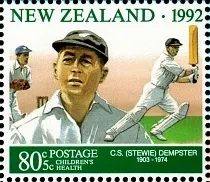






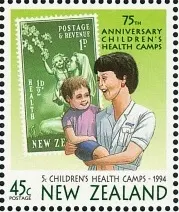
























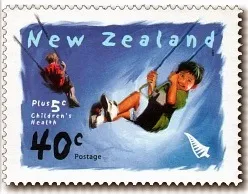
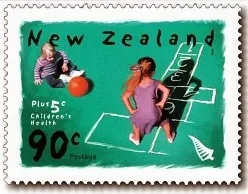


















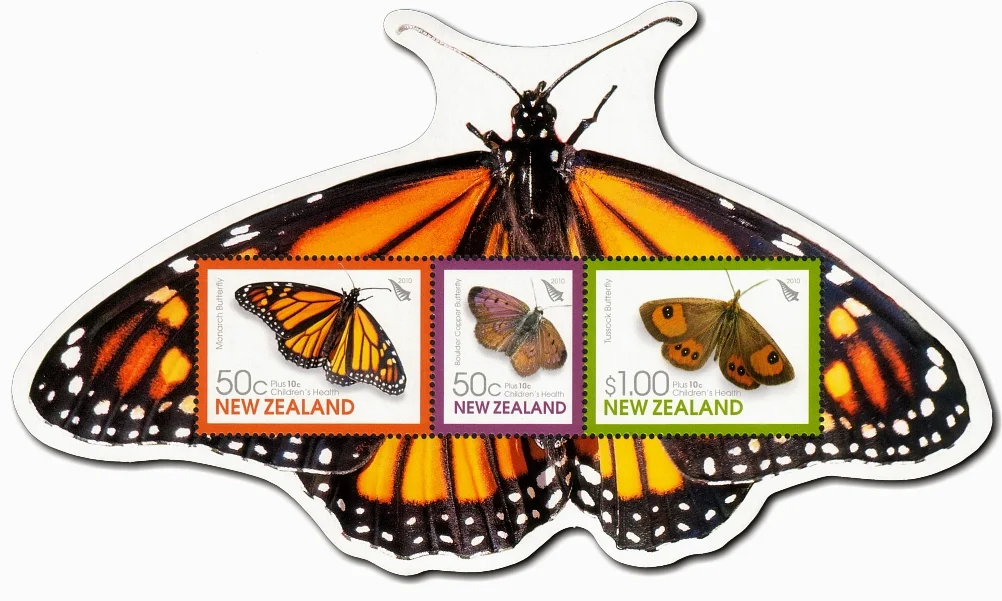



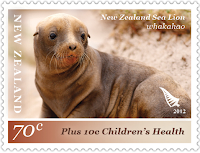
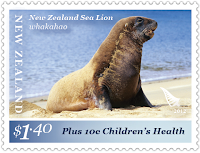

















well done for this series, great to see the printing error examples
ReplyDeleteWe appreciate your engagement with our content. To ensure a respectful and constructive community, please take note of the following:
- No Spam, Please: We do not tolerate spammy or promotional comments. Any such comments will be promptly removed.
- Moderation in Place: All comments are moderated to maintain a positive and inclusive environment. Please be patient, as it may take a little time for your comment to appear.
- Sign In with Google: To comment, please sign in using your Google account. This helps us maintain the integrity of our community and allows for better interaction.